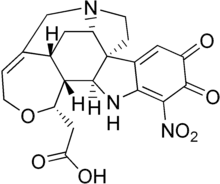 | |
| Names | |
|---|---|
| IUPAC name
4-Nitro-2,3-dioxo-2,3-dihydro-9,10-secostrychnidin-10-oic acid | |
| Systematic IUPAC name
[(4bS,7aS,8aR,13S,13aR,13bS)-1-Nitro-2,3-dioxo-2,3,5,6,7a,8,8a,11,13,13a,13b,14-dodecahydro-7,9-methanooxepino[3,4-a]pyrrolo[2,3-d]carbazol-13-yl]acetic acid | |
| Other names
2,3-Dihydro-4-nitro-2,3-dioxo-9,10-secostrychnidin-10-oic acid | |
| Identifiers | |
3D model (JSmol) |
|
| ChemSpider | |
| ECHA InfoCard | 100.008.378 |
PubChem CID |
|
| UNII | |
CompTox Dashboard (EPA) |
|
| |
| |
| Properties | |
| C21H21N3O7 | |
| Molar mass | 427.41 g/mol |
| Appearance | Yellow crystals |
| Density | 1.62 g/cm3 |
| Hazards | |
| Flash point | 374.6 °C (706.3 °F; 647.8 K) |
Except where otherwise noted, data are given for materials in their standard state (at 25 °C [77 °F], 100 kPa).
Infobox references | |
Cacotheline is an organic compound with the chemical formula C21H21N3O7. It is a nitro derivative of brucine obtained by reaction of brucine with nitric acid.[1] It is used as an indicator in the titrimetric analysis of tin ions (Sn2+).
References
- 1 2 Merck Index, 11th Edition, 1604
This article is issued from Wikipedia. The text is licensed under Creative Commons - Attribution - Sharealike. Additional terms may apply for the media files.